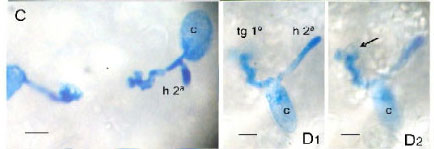Tomato powdery mildew, caused by Oidium neolycopersici, is a common disease of tomato, especially in greenhouse conditions. To investigate the nature of powdery mildew resistance, we studied the histopathology of the infection process in six different tomato genotypes: CNPH 416, CNPH 423, CNPH 1287 (Lycopersicon hirsutum), CNPH 0081 (L. esculentum var. cerasiforme), cv. Santa Cruz Kada e cv. Santa Clara (L. esculentum). Leaf discs of the 3rd, 4th e 5th leaves from plants with 5-7 true leaves were placed on water agar in Petri dishes, inoculated using fresh sporulating mycelium of tomato powdery mildew and incubated at 19-22ºC, 4000 lx and 12h photoperiod. After clearing with boiling ethanol, the discs were microscopically examined at 19 h, 8 and 9 days post inoculation to evaluate germ tube development, sporulation and disease severity. Conidial germination on foliar tissue was similar in all genotypes. Secondary hypha, appresoria and haustoria per germinated conidia were lowest in CNPH 1287 and 423, which also exhibited the lowest sporulation and disease severity. L. esculentum and L.esculentum var. cerasiforme genotypes showed the highest mildew susceptibility and CNPH 416 showed intermediate susceptibility. Powdery mildew resistance of CNPH 1287 and CNPH 423 was already evident at 19 hours after inoculation based upon the lower percentage of secondary hypha, appresoria and haustoria observed than in the susceptible ones.
tomato powdery mildew; tomato; resistance; appresorium formation; haustorium formation; histopathology






